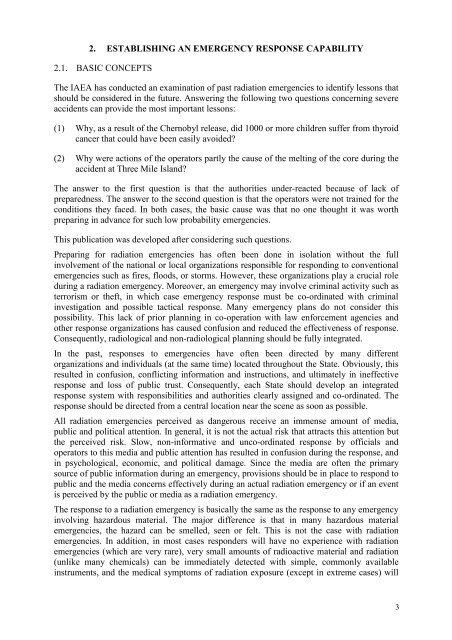epr-method (2003) - IAEA Publications - International Atomic Energy ...
epr-method (2003) - IAEA Publications - International Atomic Energy ...
epr-method (2003) - IAEA Publications - International Atomic Energy ...
Create successful ePaper yourself
Turn your PDF publications into a flip-book with our unique Google optimized e-Paper software.
2. ESTABLISHING AN EMERGENCY RESPONSE CAPABILITY<br />
2.1. BASIC CONCEPTS<br />
The <strong>IAEA</strong> has conducted an examination of past radiation emergencies to identify lessons that<br />
should be considered in the future. Answering the following two questions concerning severe<br />
accidents can provide the most important lessons:<br />
(1) Why, as a result of the Chernobyl release, did 1000 or more children suffer from thyroid<br />
cancer that could have been easily avoided?<br />
(2) Why were actions of the operators partly the cause of the melting of the core during the<br />
accident at Three Mile Island?<br />
The answer to the first question is that the authorities under-reacted because of lack of<br />
preparedness. The answer to the second question is that the operators were not trained for the<br />
conditions they faced. In both cases, the basic cause was that no one thought it was worth<br />
preparing in advance for such low probability emergencies.<br />
This publication was developed after considering such questions.<br />
Preparing for radiation emergencies has often been done in isolation without the full<br />
involvement of the national or local organizations responsible for responding to conventional<br />
emergencies such as fires, floods, or storms. However, these organizations play a crucial role<br />
during a radiation emergency. Moreover, an emergency may involve criminal activity such as<br />
terrorism or theft, in which case emergency response must be co-ordinated with criminal<br />
investigation and possible tactical response. Many emergency plans do not consider this<br />
possibility. This lack of prior planning in co-operation with law enforcement agencies and<br />
other response organizations has caused confusion and reduced the effectiveness of response.<br />
Consequently, radiological and non-radiological planning should be fully integrated.<br />
In the past, responses to emergencies have often been directed by many different<br />
organizations and individuals (at the same time) located throughout the State. Obviously, this<br />
resulted in confusion, conflicting information and instructions, and ultimately in ineffective<br />
response and loss of public trust. Consequently, each State should develop an integrated<br />
response system with responsibilities and authorities clearly assigned and co-ordinated. The<br />
response should be directed from a central location near the scene as soon as possible.<br />
All radiation emergencies perceived as dangerous receive an immense amount of media,<br />
public and political attention. In general, it is not the actual risk that attracts this attention but<br />
the perceived risk. Slow, non-informative and unco-ordinated response by officials and<br />
operators to this media and public attention has resulted in confusion during the response, and<br />
in psychological, economic, and political damage. Since the media are often the primary<br />
source of public information during an emergency, provisions should be in place to respond to<br />
public and the media concerns effectively during an actual radiation emergency or if an event<br />
is perceived by the public or media as a radiation emergency.<br />
The response to a radiation emergency is basically the same as the response to any emergency<br />
involving hazardous material. The major difference is that in many hazardous material<br />
emergencies, the hazard can be smelled, seen or felt. This is not the case with radiation<br />
emergencies. In addition, in most cases responders will have no experience with radiation<br />
emergencies (which are very rare), very small amounts of radioactive material and radiation<br />
(unlike many chemicals) can be immediately detected with simple, commonly available<br />
instruments, and the medical symptoms of radiation exposure (except in extreme cases) will<br />
3

















